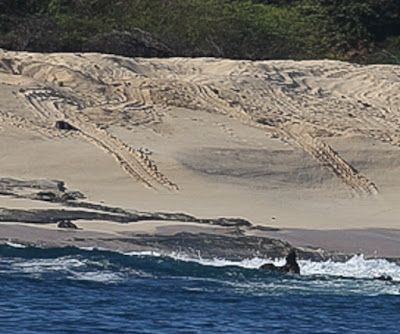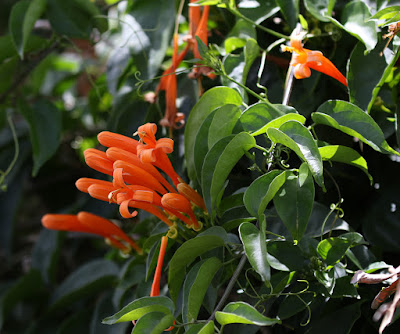Ascension Island is the third & final part of the Tristan da Cunha British Overseas Territory. Once we were anchored in Georgetown Bay, the Ascension officials came aboard & checked the Plancius's papers & our passports. We were then cleared to go ashore for the day.
The second half of our guided tour of Ascension Island will be coming in the next Post.
Black Triggerfish: There were large numbers around the gangway throughout our visit
Black Triggerfish: They occur in all the tropical oceans around the world
We had non-visa access to Ascension Island which allowed us to go on a guided day trip of the island & walk around in Georgetown. Ascension Island has a joint RAF/US Air Force airfield on the island. However, the airport runway was closed to large commercial planes in 2017 due to problems with the runway. As a consequence, some of the limited tourist options that were possible in previous years have currently shutdown. Without a visa which would have allowed us to travel around the island & the ability to hire a car or taxi, then the only option was the guided tour. This guided tour included a visit to one of the Sooty Tern colonies. Some of the punters on the previous Odyssey trips had complained that this left insufficient time to spend at the Sooty Tern colony. The guided tour gave us around an hour at the Sooty Tern colony & this seemed to be sufficient for most of the Birders. We were offered the chance of another extended visit on the following morning, but no more than a handful of people expressed an interest in that trip. The reality is like the other British islands we had visited, there was so many other interesting things to see on the island, it would have been a pity to have spent much longer at the Sooty Tern colony.
Long Beach: This is next to the quayside
Long Beach: The Green Turtle tracks indicate how popular this beach is for Green Turtles
The landing at the quayside steps was perhaps the trickiest we encountered. When a wave was high, the zodiac driver drove at the steps & Leon in the centre helped to pull the front up another step. By this time, the water level had dropped & the front of the zodiac was firmly wedged on the steps. We were then allowed to get up which involved a walk up the front of the zodiac which was angled at about 30 degrees. Surprisingly, the islanders hadn't found a better way to improve the landing on the steps over the years.Long Beach: The Green Turtle tracks indicate how popular this beach is for Green Turtles
The landing: Bob, Leon & Seba waiting to help us land
Leon has just pulled the front of the next zodiac up out of the water
Once ashore we had to wait for everybody to land before we could start on the guided tour. It was a long & hot wait for everybody to land.
The approach to the docks
There was even a passenger terminal for visitors: Although that didn't include us
The Ascension Island logo is one of the best I've seen
Finally, we were all loaded & headed off for the two minute drive to the first stop at Long Beach. At each stop, the members of the Conservation Dept gave us a short presentation talk. At this stop, it was to tell us about the history of Green Turtles on Ascension Island. In the early history of occupation of the island, the islanders collected Green Turtles & held them in this holding pen. They were then kept for months until a sailing ship came in & bought the Green Turtles. They would have been kept alive on the sailing ship, until being killed & cooked as food for the crew. Fortunately, this practice stopped in the 1950s & now the Green Turtles are fully protected. The population of Green Turtles nesting on the beaches is still increasing. A survey in 1977, suggested there were around 1,000 nests, which had increased to around 10,000 in 2012.
The Green Turtle holding pen
Long Beach
Long Beach: The sea was quite rough along the beach
Warning about one of the native species: They are a land crab that occur only on Ascension Island, as well as, Fernando de Noronha & Trindade Island
Parts of this island are incredibly arid
Parts of this island are incredibly arid
When Ascension Island was first discovered it was a hot & arid island. When Joseph Hooker visited in 1843 as part of James Ross's Antarctica Expedition, he proposed that to help provide sufficient water for the population, the high peak should be planted with trees. The hope was these trees would then capture moisture from the sea air & this would then run down & be captured. Hooker suggested a variety of suitable trees from different parts of the world. One of the stops was to the Peak or Green Mountain as it is also known. Our guide told us that the trees planted on the lower slopes were selected as trees that could cope with hotter & drier habitats, whereas the trees on the higher slopes were trees that preferred cooler & more moist habitats. As an experiment to capture water, it was incredibly successful. But it
has also left Ascension Island with a large number of introduced trees
& plants & many of the native plants are extremely threatened by
this mass introduction.
Another member of the Conservation Dept gave us a talk on their work to save the endemic plants
A display box which gives an idea of how some of the native plants would have looked
Towards the top of the Green Mountain, there is the remains of an old army base that was built when Marines were stationed on Ascension Island in 1815, after Napoleon Bonaparte was exiled to St Helena. The Conservation Dept have set up their botanical centre to grow endemic plants there, so that they can be replanted in suitable areas on the island. There is also a good walk through the Trees to see how successful this scheme has been & which included walking past one of the old water catchment sites.
The clock tower at the old Marines base
The start of the walk from the old Marines base
John Holmes with Jemi behind walking up from the old Marines base
One of the Conservation Dept staff (on the left) next to some old Marines buildings
Another view of the old Marines buildings
Part of the 19th Century water capture scheme
The old water tanks
The old water tanks
The runway in one of the typically arid lower parts of the island
The view from the top of Green Mountain: One of the reasons for the Marines base was to provide a lookout of any arriving ships
The settlement of Two Boats: Although the surrounding area looks green, most of this is actually arid Acacia-like bushes
This forest is not only around 160 years old: But it looks to be a lot older
The forest looked good
Shy White Tern: Not surprisingly there was a lack of Birds on the walk
Arjen from the Expedition staff
My mate Richard Lowe
Some excellent Lichen
I've no idea what this is or where it occurs naturally, but it looks good
US mailbox
Good to see a Rat poison trap along the walk: Rats are a major problem on Ascension Island
The start of the walk from the old Marines base
John Holmes with Jemi behind walking up from the old Marines base
One of the Conservation Dept staff (on the left) next to some old Marines buildings
Another view of the old Marines buildings
Part of the 19th Century water capture scheme
The old water tanks
The view from the top of Green Mountain: One of the reasons for the Marines base was to provide a lookout of any arriving ships
The settlement of Two Boats: Although the surrounding area looks green, most of this is actually arid Acacia-like bushes
This forest is not only around 160 years old: But it looks to be a lot older
The forest looked good
Shy White Tern: Not surprisingly there was a lack of Birds on the walk
Arjen from the Expedition staff
My mate Richard Lowe
Some excellent Lichen
I've no idea what this is or where it occurs naturally, but it looks good
US mailbox
Good to see a Rat poison trap along the walk: Rats are a major problem on Ascension Island
Finally, we all heading off to the Two Boats settlement for lunch.
Filming for the Ascension Island remake of Last of the Summer Wine was going well: Tony, Mike & Glenn





































